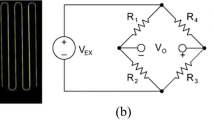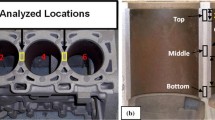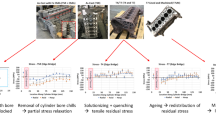Abstract
Light aluminum alloy engine blocks have successfully replaced heavy ferrous materials in order to enhance automobile fuel efficiency. Aluminum engine blocks with gray iron cylinder liners are prone to tensile residual stresses along the cylinder bridges, which may cause distortion and reduce engine efficiency. In this study, the sectioning technique was used as a means for measuring average residual stresses in critical regions in engine blocks subjected to different metallurgical parameters. It was found that the stresses could be higher than 100 MPa in tension after casting. Relaxation of residual stresses was observed after solution heat treatment, freezing treatment, and aging compared to the initial stage, depending on the geometry and size of the workpiece. Relaxation rate was found to be affected by the size of the workpiece.












Similar content being viewed by others
References
E. Carrera, A. Rodriguez, J. Talamantes, S. Valtierra, R. Colas, Measurement of residual stresses in cast aluminium engine blocks. J. Mater. Process. Technol. 189(1), 206–210 (2007)
D.A. Lados, D. Apelian, L. Wang, Minimization of residual stress in heat-treated Al–Si–Mg cast alloys using uphill quenching: mechanisms and effects on static and dynamic properties. Mater. Sci. Eng. A 527(13–14), 3159–3165 (2010)
H. Yamagata, The Science and Technology of Materials in Automotive Engines (Elsevier, New York, 2005)
G. Dolan, J. Robinson, Residual stress reduction in 7175-T73, 6061-T6 and 2017A-T4 aluminium alloys using quench factor analysis. J. Mater. Process. Technol. 153, 346–351 (2004)
A. Lombardi, A Study of Cylinder Bore Distortion in V6 Aluminum Alloy Engine Block (Ryerson University, Tornoto, 2011)
D. Wiesner, T. Watkins, T. Ely, S. Spooner, C. Hubbard, J. Williams, Residual stress measurements of cast aluminum engine blocks using diffraction. Int. Cent. Diffr. Data Adv. X-Ray Anal. 48, 136–142 (2005)
A. Lombardi, F. D’Elia, C. Ravindran, D. Sediako, B.S. Murty, R. Mackay, Interplay between residual stresses, microstructure, process variables and engine block casting integrity. Metall. Mater. Trans. A 43A(13), 5258–5270 (2012)
A. Lombardi, F. D’Elia, C. Ravindran, R. MacKay, Replication of engine block cylinder bridge microstructure and mechanical properties with lab scale 319 Al alloy billet castings. Mater. Charact. 87, 125–137 (2014)
J.R. Davis (ed.), Aluminum and Aluminum Alloys (ASM International, Materials Park, 1993)
P.J. Withers, Residual stress and its role in failure. Rep. Prog. Phys. 70(12), 2211–2264 (2007)
J. Robinson, D. Tanner, C. Truman, 50th Anniversary article: the origin and management of residual stress in heat-treatable aluminium alloys. Strain 50(3), 185–207 (2014)
M. Araghchi, H. Mansouri, R. Vafaei, Y. Guo, A novel cryogenic treatment for reduction of residual stresses in 2024 aluminum alloy. Mater. Sci. Eng. A 689, 48–52 (2017)
A. Lombardi, D. Sediako, C.R. Ravindran, R. Mackay, Residual stress mapping along the cylinder bores of Al alloy engine blocks subjected to production solution heat treatment schedule. SAE Int. J. Mater. Manuf. 7(2014-01-0837), 415–420 (2014)
L.A. Godlewski, X. Su, T.M. Pollock, J.E. Allison, The effect of aging on the relaxation of residual stress in cast aluminum. Metall. Mater. Trans. A 44(10), 4809–4818 (2013)
A. Lombardi, D. Sediako, A. Machin, C. Ravindran, R. MacKay, Effect of solution heat treatment on residual stress in Al alloy engine blocks using neutron diffraction. Mater. Sci. Eng. A 697, 238–247 (2017)
S.S. Mohamed, A.M. Samuel, H.W. Doty, S. Valtierra, F.H. Samuel, Relation between residual stresses and microstructure evolution in Al–Si alloys based on different casting parameters. Philos. Mag. 99(3), 284–305 (2019)
A. Lombardi, C. Ravindran, D. Sediako, R. Mackay, Determining the mechanism of in-service cylinder distortion in aluminum engine blocks with cast-in gray iron liners. Metall. Mater. Trans. A 45A(13), 6291–6303 (2014)
J.G. Kaufmann, E.L. Rooy, Aluminum Alloy Castings: Properties, Processes, and Applications (ASM International, Materials Park, 2004)
A. Egner-Walter, M. Kothen, Using stress simulation to tackle distortion and cracking in castings. Metall. Sci. Technol. 24(2), 19–25 (2006)
Author information
Authors and Affiliations
Corresponding author
Additional information
Publisher's Note
Springer Nature remains neutral with regard to jurisdictional claims in published maps and institutional affiliations.
Technical Review and Discussion
Technical Review and Discussion
Addendum: Author Replies to Reviewer Comments on Development of Residual Stresses in Al–Si Engine Blocks Subjected to Different Metallurgical Parameters
Comment 1:
What is meant by as-received and as-cast blocks and what are the differences in heat treatment applied?
Reply:
All the I-4 engine blocks used in this study were supplied after casting and sand reclamation (removal of casting from the sand mold). No T7 treatment was applied. It should be noted that apart from four blocks supplied initially by Nemak which were subjected to the industrial heat treatment, the other blocks were received in the as-cast state (without heat treatment) and the heat treatments proposed in the present study were carried out using these blocks. The industrially heat treated blocks were used for verifying the reliability of the experimental procedures. The values obtained were found to be comparable with those published by Carrera et al. 1 (Nemak). The as-received values quoted in the figures reporting the results are therefore those obtained from the as-cast blocks. Table 2 provides the details of the industrial heat treatment given to engine blocks.
Comment 2:
How were the thermal expansion values determined?
Reply:
The thermal expansion values (2.4 for Al and 1.5 for gray cast iron) were taken from Reference13 (Lombardi et al., Residual stress mapping along the cylinder bores of Al alloy engine blocks subjected to production solution heat treatment schedule) and Reference 1 (Carrera et al., Measurement of residual stresses in cast aluminum engine blocks). Other sources (J. R. Davis, Metals Handbook Desk Edition, ASM, 1998) reveal that the thermal expansion coefficient for gray cast iron is 10.5 × 10−6 (°C)−1 or 1.05 × 10−5 (°C)−1 whereas that for aluminum is 2.31 × 10−5 (°C)−1. The values have been kept as ~ 2.4 and ~ 1.5 × 10−5 (°C)−1 in the revised manuscript with Reference 13 given next to it.
Comment 3:
Natural aging—this alloy is subject to significant natural aging. Can you mention the time delays between casting and residual stress measurements and the effects of natural aging on mechanical properties?
Reply:
In order to prevent natural aging, the samples were stored either in a fridge or the residual stress measurements were performed as soon as the specific treatment was completed.
Comment 4:
Consider revising Elastic modulus in the equation. On p. 8—our measurements for this type of alloy show values at least 10% above that of wrought Al (70 GPa); the silicon phase is known to raise E and to significantly reduce thermal expansion coefficient.
Reply:
This value was taken from the References 1 and 13 in which the same alloy material was used.
Comment 5:
On p. 10 para 2, the authors emphasize the importance of creating a temperature gradient in the casting during refrigeration, but in the next paragraph the description of the refrigeration process implies minimal temp gradient and “allows it to stabilize.” What temperature gradient are you trying to achieve? Cool the liner faster than the Al, or vice versa? Again, on heating are you wanting to heat the liner faster than the Al? How does that lower the residual stress state once the temperature gradient dissipates?
Reply:
The use of the cryogenic treatment was explained in para 2 on p. 10. The next para described the process used in the present study. Due to the limitations of the lab facilities (freezer) available, the freezing temperature used was – 30 °C (as opposed to the – 100 °C temperature used in industrial conditions). The term ‘shallow’ was used for this reason only. Also, the phrase ‘allowing it to stabilize’ was meant to convey that the temperature of the casting was allowed to reach the freezing temperature. Likewise, ‘stabilization’ implied that the casting attained the freezing temperature throughout. We have modified these two sentences in the revised manuscript. The frozen casting is then exposed to a sudden increase in temperature when immersed in hot water at 60 °C.
After SHT + quenching, tensile residual stresses are produced in the engine block. During the freezing treatment performed thereafter, the block is left to freeze to the required temperature. Then, it is removed from the freezer and immersed in hot water (reverse quenching). This action results in the production of compressive residual stresses opposite to that produced in the SHT + quenching step. If the temperature of the hot water is increased, larger compressive residual stresses will be developed as the temperature difference between the frozen block and water bath is larger.
Comment 6:
On p. 11, end of para 1, a cooling rate of 15.5 °C/min is posited, but the graph shows non-linear cooling. The overall rate is closer to 7.7 °C/min. Please state the instantaneous temperature for the quoted cooling rate conditions. It seems to me that high cooling rates at the highest temperature favors less creep and hence encourages higher residual stresses in the Al. Have you considered that the elastic limit of the quenched material is lower in the liquid-quenched block compared to the air-cooled block, which can partially age and harden on air cooling?
Reply:
The cooling rate quoted was calculated in the region between 400 and 200 °C. The elastic limit was assumed to be constant in all our work.
Comment 7:
On p. 14, para 4 the title sentence mentions “two facts” that contribute to lower residual stress with liquid quenching from the SHT, but only one is given. Please state second fact.
Reply:
The paragraph referred to is quoted below and pointed out to the two facts:
The reason for this contradiction is based on two facts related to our experiments. Firstly, the engine blocks contain two different materials with significant differences in their coefficients of thermal expansion (αAl = ~2.4 × 10−5 K−1, αFe = ~1.5 × 10−5 K−1) and secondly, the rate of contraction during quenching will differ given that the cooling rate will be different for the cast iron liners (CI liners) versus the surrounding aluminum.
Comment 8:
On p. 15 para 1 the last sentence states that differential cooling between the liners and the Al block reduces the dimensional mismatch between the two components. This seems reasonable during the quench, but what happens when the block equilibrates at room temperature and the temperature gradient disappears? Assuming that the parts are in equilibrium at the SHT, a calculation of the dimensional mismatch between the liner and the Al block, using your values for thermal expansion coefficient, one would expect quite large differences (0.9/C times 480 °C = 0.43% strain and 302 MPa)—differences sufficient to produce quite high stresses in the Al. If creep relaxation is contributing to a reduction in residual stress, doesn’t liquid quenching inhibit any opportunity for creep?
Reply:
During solution treatment, residual stresses in Al alloy engine blocks measured by neutron diffraction (in Reference 15 ) have shown that most of the stresses are relieved over the duration of the solution treatment, and that the remaining residual stress is much lower compared to the residual stress that was present in the as-cast block. During the water quenching that follows the solution treatment, the water quench may produce larger residual stresses in regions of the casting that are subjected to large thermal gradients. These stresses are partially relaxed during the subsequent aging treatment, at which stage the creep relaxation could be considered.
Rights and permissions
About this article
Cite this article
Mohamed, S.S., Samuel, A.M., Doty, H.W. et al. Development of Residual Stresses in Al–Si Engine Blocks Subjected to Different Metallurgical Parameters. Inter Metalcast 14, 25–36 (2020). https://doi.org/10.1007/s40962-019-00342-z
Published:
Issue Date:
DOI: https://doi.org/10.1007/s40962-019-00342-z




